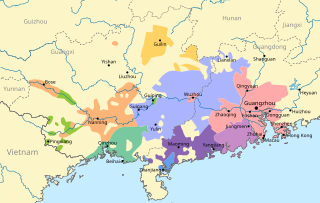
Yue is a branch of the Sinitic languages primarily spoken in Southern China, particularly in the provinces of Guangdong and Guangxi (Liangguang).

Nian gao, sometimes translated as year cake or New Year cake or Chinese New Year's cake, is a food prepared from glutinous rice flour and consumed in Chinese cuisine. It is also simply known as "rice cake". While it can be eaten all year round, traditionally it is most popular during the Chinese New Year. It is considered good luck to eat nian gao during this time of the year because nian gao (年糕) is a homonym for "higher year" or "grow every year" (年高), which means "a more prosperous year". The character 年 is literally translated as "year", and the character 糕 (gāo) is literally translated as "cake" and is identical in sound to the character 高, meaning "tall" or "high". Nian gao (年糕) also is an exact homonym of "sticky cake" (黏糕/粘糕), the character 黏/粘 (nián) meaning "sticky".
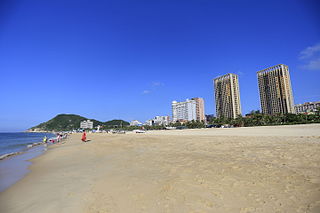
Yangjiang, alternately romanized via Cantonese as Yeungkong, is a prefecture-level city in southwestern Guangdong Province in the People's Republic of China. It borders Maoming to the west, Yunfu to the north, Jiangmen to the east, and looks out to the South China Sea to the south. The local dialect is the Gaoyang dialect, a branch of Yue Chinese. During the 2020 census, its population was 2,602,959 inhabitants of whom 1,292,987 lived in the built-up and largely urbanized area comprising Jiangcheng District and Yangdong County.
Zheng Guogu is an artist based in Yangjiang in the Guangdong province of China, one of three artists in the artist collective known as Yangjiang Group. In 1992, he graduated from the printmaking department of the Guangzhou Academy of Fine Arts.
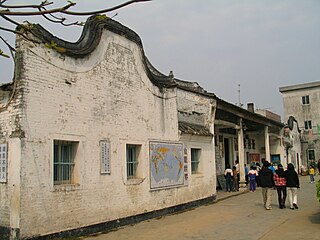
Jiangcheng is a district of Yangjiang, Guangdong province, China.

Yangchun, alternately romanized as Yeungchun, is a county-level city in southwestern Guangdong, China, administered as a part of the prefecture-level city of Yangjiang. Yangchun has an area of 4,055 km2 (1,566 sq mi) and had approximately 1.05 million inhabitants in 2003.
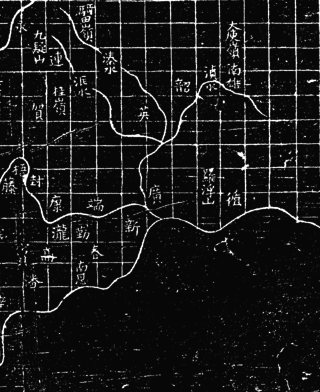
Yangdong District is a district of the city of Yangjiang, Guangdong Province, China.
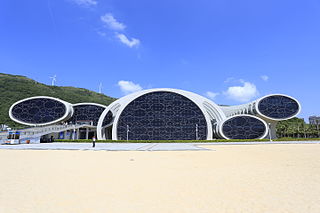
The Maritime Silk Route Museum is the name of a museum on Hailing Island, Yangjiang, Guangdong Province, China. Work on the museum started in late 2004 and the museum opened to the public on 24 December 2009.
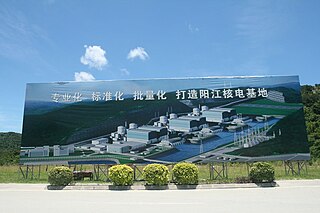
The Yangjiang Nuclear Power Station is a nuclear power plant in Guangdong province, China. The site is Dongping Town, Yangjiang City in western Guangdong Province. The station has six 1,000 megawatt (MW) CPR-1000 pressurized water reactors (PWRs). The plant began commercial operation in March 2014, and as of 2019 is the largest nuclear power station in China.
The 1969 Yangjiang earthquake occurred on 26 July, at 6:49 am, Beijing local time. It had a magnitude of 6.4 on the moment magnitude scale and a maximum perceived intensity of VIII (Severe) on the Mercalli intensity scale. It struck the city of Yangjiang, causing over 10,700 houses to collapse and severely damaging a further 36,000. The earthquake also caused landslides and sandblows observed along the coast and along some rivers in the area of Yangjiang. The earthquake was also felt in Hong Kong. There were an unconfirmed total of 3,000 deaths.
The CPR-1000, or CPR1000 is a Generation II+ pressurized water reactor, based on the French 900 MWe three cooling loop design (M310) imported in the 1980s, improved to have a slightly increased net power output of 1,000 MWe and a 60-year design life.
The State of Shěn was one of the various Chinese states during the Zhou dynasty and the Spring and Autumn period located in modern-day Henan. Its founder is unknown, although a possible founder is one of the sons of King Wen of Zhou.
The Port of Yangjiang is a natural estuary port on the coast of the city of Yangjiang, Guangdong Province, People's Republic of China. In 2013 it had a total cargo throughput of 21 million tonnes, an increase of 30%, mostly handling ore and coal.
The Yangjiang Group is a Chinese artist collective founded in 2002 by Zheng Guogu, Chen Zaiyan, and Sun Qinglin. The group's name takes after their hometown in Yangjiang, Guangdong Province. The Yangjiang Group's works have been exhibited in Europe and Asia. Their works show a strong attachment to a sense of place in their hometown.
Yangjiang is a prefecture-level city in Guangdong, China.

Gao Fu, also known as George Fu Gao, is a Chinese virologist and immunologist. He served as Director of the Chinese Center for Disease Control and Prevention from August 2017 to July 2022 and has been Dean of the Savaid Medical School of the University of Chinese Academy of Sciences since 2015.
Wei Hongguang is a former Chinese politician who spent his whole career in his home-province Guangdong. He was investigated by the Chinese Communist Party's anti-graft agency in January 2020. Previously he served as deputy secretary-general of Guangdong. He entered the workforce in July 1981, and joined the Chinese Communist Party (CCP) in March 1984.

The Yangjiang Massacre was a series of massacres that took place in Yangjiang, Guangdong during the Chinese Cultural Revolution. According to the Chinese Communist Party (CCP) committee in Yangjiang, a total of at least 3,573 people died in the Yangjiang Massacre. Specifically, the massacre in Yangjiang County took place from January 1, 1968, to mid-January 1969, killing 909 people, while the massacre in Yangchun County began on September 23, 1967, killing 2,664 people in total. During the massacre, methods of slaughter included beating with hoes or clubs, gun shooting, drowning, stabbing, stoning, exploding with fireworks, burning with kerosene, live burial, and so on.
The following radio stations broadcast on FM frequency 97.2 MHz:
